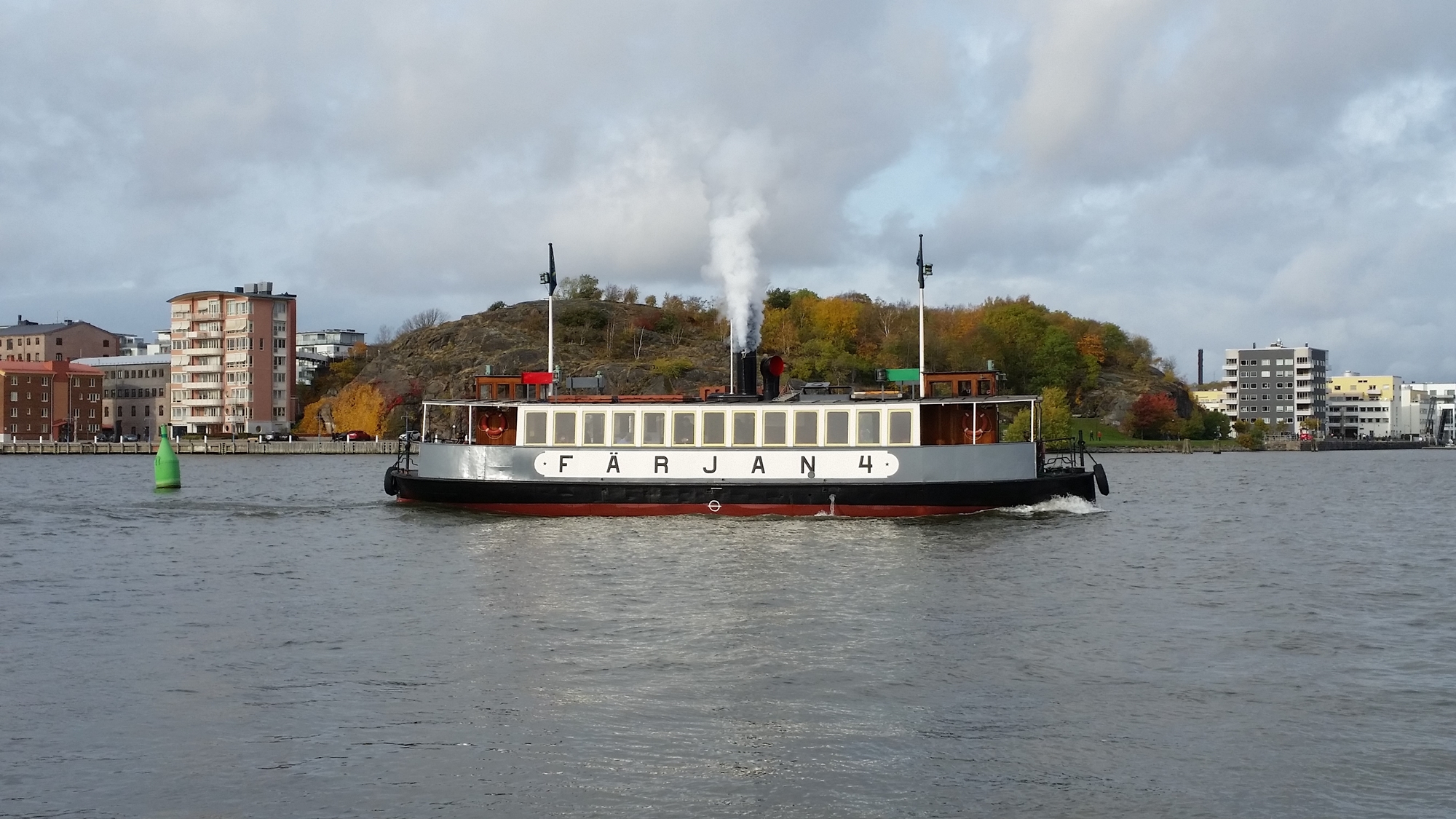The FÄRJAN 4 is the only remaining steam ferry for local traffic across the river in Gothenburg. The FÄRJAN 4, built in 1920, operated the Residensbron - Götaverken line for over 30 years and remained as a reserve ferry until 1970. The ferry was handed over as a gift in 1972 to the Maritime Museum, which pledged to "preserve the ferry in working order".
The ship
The FÄRJAN 4 is built as a steam-powered passenger ferry at Motala Verkstad 1920. It is 20.55 meters long, 5.35 m wide and has a draft of about 2.35 m with full load. For traffic in the inner harbor area, the ferry can take 100 passengers (originally 195). The salon has 50 seats. The crew consists of a master, engineer and deckhand.
The hull of the ferry is built of steel in riveted design and reinforced for operating in ice. It has a rudder and a propeller on each end. The rudders are interconnected and must be turned 180 degrees when the direction of travel is changed. The 4th is largely unchanged since the delivery in 1920. A noticeable change took place in 1934 when the ferry got new larger wheelhouses and roofs over the front and aft decks.
The FÄRJAN 4 is powered by a two-cylinder compounding machine with a surface condenser. The cylinder diameters are 190 resp. 420 mm and the stroke 320 mm. The engine power is 70 indicated horsepower at about 180 rpm. The engine has a Stephenson's valve gear for reversing between front and back. Because the propeller shaft is continuous, the two four-bladed propellers are driven simultaneously. The cruising speed is 7 knots. The steam boiler is of the Scottish type with a fire tube and is fired with coal. The working pressure is 9.5 kg / cm2. During normal ferry traffic, the coal consumption is 25 kg / hour. For the power supply, there is a steam turbine-powered generator that provides 110 V direct current.
The FÄRJAN 4 as a workhorse
Gothenburg Port Authority's steam ferry traffic, dates back to 1837. The FÄRJAN 4 was delivered in October 1920 by Motala Verkstad to the Port of Gothenburg. It was a twin sister with the one just before it delivered as FÄRJAN 3. The FÄRJAN 4 was deployed on the line Residensbron - Götaverken, where it operated every 15 minutes in intense shipping traffic from six in the morning to one at night. On Sundays, the service started an hour later and ended an hour earlier. One day a week, the ferry was taken out of service for a few hours for bunkering coal and cleaning at the Port's shipyard. During peak hours in the morning and afternoon, The FÄRJAN 5 went as an extra ferry, which gave a 7 1/2 minute interval between trips.
That the ferry traffic across the river was extremely important is evident from the fact that in 1925, for example, 160,000 passengers per month travelled on the Residensbron - Götaverken line. On June 2nd 1954, traffic was moved from Götaverken to a new ferry terminal in the then newly built Lundbyhamnen. At the same time, the two steam ferries were replaced by the new motor ferry HUGO HAMMAR.
The FÄRJAN 4 then became a spare ferry and replacement on the various ferry lines until July 1970. In 1968, however, the "4" returned as a regular on its old line since the motor ferry had been deployed on line 4. Also in 1969 and 1970, the 4 for long periods on its old line while the motor ferry was instead in reserve. On 31 July 1970, line 5 ended. The FÄRJAN 4 became redundant and was laid up at the Port's shipyard on Ringön.
The FÄRJAN 4 will be a museum ferry
On 1/1 1972, the Port Board's ferry service was discontinued and the remaining Haket - Hisingstad line was transferred to Styrsöbolaget. The Port Authority handed over the FÄRJAN 4 on 29 June 1972 as a gift to the Maritime Museum in Gothenburg. The purpose was to preserve the ferry for the future. However, the Maritime Museum had no opportunities to preserve the ferry in a serviceable condition. Faced with the threat that the ferry would only lie like a dead museum ship, interest was aroused from the non-profit association Sällskapet Ångbåten.
On 5 February 1973, an agreement was reached in which the Steamboat Company was allowed to dispose of the ferry in exchange for a commitment to preserve it in a operational condition. All work with both driving and maintenance of The FÄRJAN 4 is carried out entirely non-profit by the members of the Steamboat Society. The ferry's formal owner The Board of the Gothenburg Maritime Museum Foundation has the financial responsibility for the ferry. Repair and maintenance work is carried out taking into account historical aspects, at the same time, the ferry must meet current safety requirements in order to be used in passenger traffic.
Since October 2016, the ferry has not been in service due to a breakdown on the steam boiler. The owner of the ferry does not have money to repair the boiler. The steamboat company has applied for a grant to repair the steam boiler for several years. The cost is estimated at SEK 1.6 million. As of this writing in May 2019, notification of this year's applications for grants is expected. If enough money comes in, the goal is to repair the steam boiler in the autumn of 2019 so that the ferry can be put into service in the summer of 2020 when it turns 100 years old.
This goal was accomplished, and on 10 October 2020 she steamed yet again on the Göteborg waterfront!


